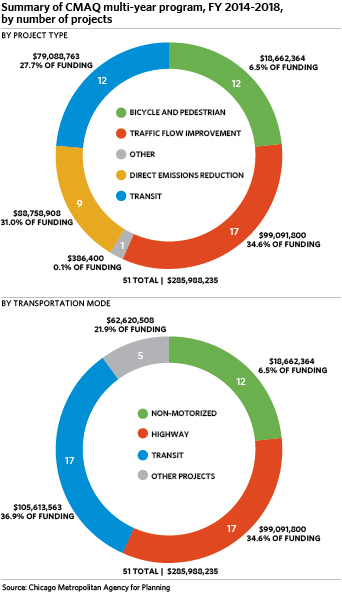CMAP Press Release, 11-12-13
More than 50 projects will receive $286 million to reduce congestion, improve air quality in metropolitan Chicago
Federal surface transportation investments support implementation of the GO TO 2040 comprehensive regional plan
CHICAGO, November 12, 2013 -- Residents of metropolitan Chicago will benefit from improved transit, roads, bicycle, and pedestrian facilities through $286 million in federal transportation funds targeted over the next four years to support the GO TO 2040 comprehensive regional plan's goals for reducing congestion and improving air quality.
Allocated for the seven-county region of Cook, DuPage, Kane, Kendall, Lake, McHenry, and Will by the Chicago Metropolitan Agency for Planning (CMAP), these funds are made available through the federal Congestion Mitigation and Air Quality (CMAQ) Improvement Program. Combined with previous CMAQ funding cycles, these awards make up a five-year regional program of $582 million.
The 51 projects were selected and reviewed publicly by CMAP committees made up of transportation experts and stakeholders. Highlights include:
- $935,920 for expansion of Pace's I-55 bus-on-shoulder service, from Kedzie Ave. to Lake Shore Drive
- $3 million to expand the City of Chicago's popular Divvy bike-sharing program
- $3.73 million for the Cal-Sag bicycle-pedestrian trail in Blue Island, part of the Millennium Reserve open space project
- $10.58 million to McHenry County for an innovative "continuous flow interchange" at Randall Rd. and Algonquin Rd.
- $15.78 million for a bus terminal at Union Station in Chicago
- $20.8 million for up to 32 hybrid engines to be used by the Chicago Transit Authority's Ashland Ave. Bus Rapid Transit project
- $34 million for construction of the Illinois Tollway's Elgin O'Hare Western Access (EOWA) project
- $23.28 million for grade separation where the Union Pacific Railroad meets Touhy Ave. in Des Plaines, relieving congestion from EOWA construction
- $35.25 million to convert 31 Indiana Harbor Belt Railroad locomotives to compressed natural gas
In addition to their congestion-reduction benefits, the project are collectively estimated to eliminate 298.9 kilograms daily of volatile organic compound (VOC) emissions, which are among the primary precursors to ground-level ozone that is harmful to breathe.
"CMAP is deeply committed to transparency in selecting projects that maintain and modernize our current transportation system as recommended in the GO TO 2040 plan," said CMAP Board chairman Gerald Bennett, mayor of Palos Hills. "These projects will improve highway corridors, create new bicycle paths, develop new transit service, and enhance overall connectivity while improving air quality in the region."
Reviewed and analyzed by committees of subject-matter experts and stakeholders based on competitive proposals, the proposed projects respond to priorities recommended by GO TO 2040, which emphasizes investments to maintain and modernize the existing transportation system, adopt best practices in new technologies, establish seamless coordination between transportation modes, and include transit components as part of major highway capital projects.
CMAP encouraged proposals from the public and private sectors. To be federally eligible, each project must have as its "sponsor" a state agency or unit of government, such as a county, municipality, township, park district, forest preserve district, or library district. Most projects require an 80:20 split of federal to local dollars. CMAP received more than 121 applications requesting over $896 million in federal funds.
The CMAQ project guidelines describe eligible activities that include:
- Transit Improvements (e.g., new rail systems, bus service or vanpools; projects that increase the convenience of transferring between transit services; transit equipment that increases the frequency or operating speed of bus or rail)
- Commuter Parking Facilities (e.g., new or expanded park-n-ride or other parking structures)
- Traffic Flow Improvements (e.g., roadwork that removes specific bottlenecks)
- Intersection Improvements (e.g., to ease flow through existing intersections by adding turn lanes and/or traffic signals, including signal synchronization equipment)
- Bicycle and Pedestrian Facilities (e.g., lanes, trails, or programs that facilitate cycling or walking as an alternative to automobiles)
- Diesel Emissions Reduction (e.g., enhancements or replacements of vehicles or locomotives to improve engine idling, use lower-emission fuels, or run more cleanly)
-
Other (e.g., projects that don't fit into the above categories but result in reduced emissions, such as the Illinois Environmental Protection Agency's Ozone Alert public information program, rideshare incentive programs, interoperable emergency communications equipment, and programs to reduce emissions related to "cold starts" of engines)
The CMAQ program was created in 1991 as part of the federal Intermodal Surface Transportation Efficiency Act (ISTEA) and has been continued by the successor transportation bills known as the Transportation Equity Act for the 21st Century (TEA-21) in June 1998, the Safe, Accountable, Flexible, Efficient Transportation Equity Act: A Legacy for Users (SAFETEA-LU) in August 2005, and the Moving Ahead for Progress in the 21st Century Act (MAP-21) in July 2012.
--END--
About CMAP. The Chicago Metropolitan Agency for Planning (CMAP) is the comprehensive regional planning organization for the northeastern Illinois counties of Cook, DuPage, Kane, Kendall, Lake, McHenry, and Will. By state and federal law, CMAP is responsible for producing the region's official, integrated plan for land use and transportation. The agency's innovative GO TO 2040 planning campaign develops and implements strategies to shape the region's transportation system and development patterns, while also addressing the natural environment, economic development, housing, education, human services, and other quality-of-life factors. See http://www.cmap.illinois.gov/ for more information.
